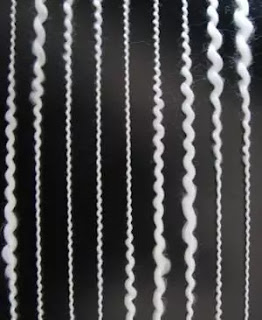YARN AND IT'S CLASSIFICATION
YARN:-
Yarn is a strand of threads used for sewing, knitting or weaving, or a tale of almost unbelievable entertainment or adventure.
Classification of simple yarn and complex yarn:-
Yarns can be categorized into simple and complex yarn.
SIMPLE YARN:
Simple yarns are smooth, even in size, and have an equal number of turns or twists per inch, throughout the yarn length, which makes it durable.
A simple yarn usually produces smooth fabrics.
But a combination of simple yarns having different sizes, twist or fibers can produce interesting effects in fabric.
Simple yarn is classified into four types they are
Single yarn
Ply yarn
Cord or cable
Doubled yarn
1. SINGLE YARN:
Composed of short staple fibers with sufficient twist to hold them together.
Composed of several filaments held together by sufficient twist.
Made from monofilament yarn made from strips of material such as paper and foil.
2. PLY YARN:
The ply yarns are made by twisting together two or more single yarns of the same different types.
Therefore on untwisting a ply yarn, it seperates into two or more plys two single twisted together make a two ply whereas three single make up a three ply yarn.
When more tham three single are used, it makes up a multi ply or multiple ply yarns.
Ply yarns are more expensive.
Most fabrics are made of ply yarns.
3. CORDED OR CABLE YARN:
Cable yarns are produced by twisting together two or more plied yarns.
This process involves twisting of plied yarns into opposite direction, which is s/z/s or z/s/z.
This type of twist causes the plies to hold tightly, hard, rough and strong yarns.
4. DOUBLED YARN:
Doubled yarn refers to two or more single strands treated as one in the weaving process, but the strands are not twisted together.
These yarns are used for ornamental effects along with providing additional strength.
This yarn have little twist, they produce luster and softness.
COMPLEX YARN:
Complex yarns are usually uneven in size.
Due to modification in the form of irregularitiesintroduced in their appearance at the time of manufacturing.
These yarns are known as fancy yarns.
These yarns provide surface interest iin the fabric and can be single, double, cord or modified cord.
These yarns are made up of a basseor core, an effect, and tie or binder.
The following are examples of complex single yarns
- SLUB YARN
- THICK AND THIN YARN
- FLOCK YARN
1. SLUB YARNS:
A slub yarn can be single or twoo ply with majority of them being single yarn.
These yarns are made by uneven twisting of stable length fibers.
The yarns are coarde with low twist and show irregularities.
It is commonly used for ornamental effect in shahtung and tweed.
2. THICK AND THIN YARNS:
Thick and thin yarns.
Thick and thin yarns have uneven diameter and looksimilar to slub yarns.
These yarns are made of filament-ength fibers.
During the manufacturing time pressure is applied on yarns.
This result is making the yarn thicker at some places and thinner at some places.
3. FLOCK YARNS:
Flock or flake yarns are single yarns in which small tufts of fibers are inserted at regular intervals and held in place by the twist of a single yarns.
The tufts can be round or elongated and frequently differ in the colors from the base yarn.
COMPLEX PLY OR FANCY YARNS:
Ratine yarn is a complex ply yarn in which, the effect ply is twisted in a spiral arrangement around the ground ply.
At intervals, a longer loop is thrown out, kinds back on it, and is held in place by the blinder.
The ratine yarn's small loops on its surface give the yarn a taut, rough-surfaced effect. These yarns are used in mostly in furnishings.
- BOUCLE YARN
- LOOP YARN
- NUB YARN
- SPIRAL YARN
- CHENILLE YARN
BOUCLE YARN:
It requires a minimum of three component yarns: cone, effect, and binder, and it are produced in two stages.
The main difference between a boucle yarns is that the wavy projections, a result of greater overfeeding of the effect yarn during the first twisting stage.
On the account of greater overfeed. The effect spirals very loosely around the core following the first twisting stage.
The wavy projections can be more variable yarn appearance.
LOOP YARN:
The threading arrangement of the component yarns to form loops.
The considerations to for the loop yarns are the type of fibers. Level of twist applied and the percentage of over feed employed at the profile stage.
NUB YARN:
Nub yarn is otherwise known as knot, knop, and spot yarns.
Knop yarn contains prominent bunches of its component arranged at regular or irregular intervals.
Using rollers capable of being operated independently usually makes this fancy yarn:
Core component
Intermittent delivery and effect component
Continuous delivery
So the effect component joins the core and is gathered into bunch or knop by the insertion of twist.
SPIRAL YARN:
Typically, two single yarns of different thickness and twist level are plied together with slight over feed of course yarn.
The spiral fancy yarn is a plied yarn with smooth spiraling of one component around the others.
Delivering one or more of its components at a greater speed can produce fancy yarn with spirals, so the shorter length of the component forms the core, while the greater length of the components creates the spirals.
CHENILLE YARN:
This was made originally by the leno weaving two weft yarns are placed between each crossing of the weft yarns
After weaving the weft, length extended between the wrap yarns is cut to produce the pile effect.

















Comments
Post a Comment